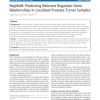Free Online Productivity Tools
i2Speak
i2Symbol
i2OCR
iTex2Img
iWeb2Print
iWeb2Shot
i2Type
iPdf2Split
iPdf2Merge
i2Bopomofo
i2Arabic
i2Style
i2Image
i2PDF
iLatex2Rtf
Sci2ools
BMCBI
2011
2011
RegNetB: Predicting Relevant Regulator-Gene Relationships in Localized Prostate Tumor Samples
Background: A central question in cancer biology is what changes cause a healthy cell to form a tumor. Gene expression data could provide insight into this question, but it is difficult to distinguish between a gene that causes a change in gene expression from a gene that is affected by this change. Furthermore, the proteins that regulate gene expression are often themselves not regulated at the transcriptional level. Here we propose a Bayesian modeling framework we term RegNetB that uses mechanistic information about the gene regulatory network to distinguish between factors that cause a change in expression and genes that are affected by the change. We test this framework using human gene expression data describing localized prostate cancer progression. Results: The top regulatory relationships identified by RegNetB include the regulation of RLN1, RLN2, by PAX4, the regulation of ACPP (PAP) by JUN, BACH1 and BACH2, and the co-regulation of PGC and GDF15 by MAZ and TAF8. These target...
Biometrics | BMCBI 2011 | Gene Expression Data | Human Gene Expression | Prostate Cancer Progression |
| Added | 24 Aug 2011 |
| Updated | 24 Aug 2011 |
| Type | Journal |
| Year | 2011 |
| Where | BMCBI |
| Authors | Angel Alvarez, Peter J. Woolf |
Comments (0)

